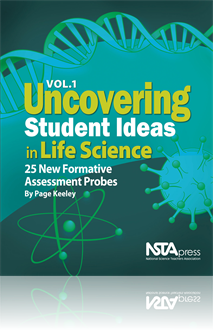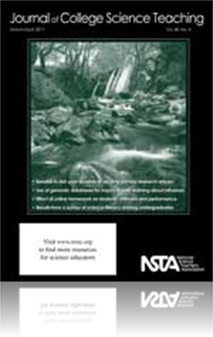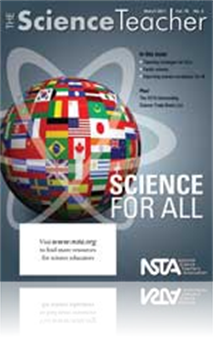All Resources
Book Chapter
The Rock Cycle: Rock Formation and Change
A single rock could provide an example of how slowly most geological changes occur on Earth. If you picked up a rock and kept it for the rest of your life, you would probably notice that it changes little, if at all. Yet, rocks can and do change; it ...
Book Chapter
Students, in this activity, use a globe and lamp to model Earth’s orbit. From this concrete model, they see and understand that the cause of Earth’s seasons is the tilt of its rotational axis....
Book Chapter
The greenhouse effect refers to the way Earth’s atmospheric gases create a barrier that allows the heat from the Sun to penetrate and be absorbed by Earth’s surface. The heat is trapped, much like in a greenhouse. The greenhouse effect on Venus w...
Book Chapter
Every 29.5 days, the Moon’s shape appears to change in a predictable cycle. We call the shapes phases of the Moon. This activity will show how the Moon’s orbit causes the Moon’s phases. Students use Ping-Pong or Styrofoam balls to model the way...
Book Chapter
Students, in this activity, measure distances by walking heel-to-toe in the unit “student minute.” This is to gain an intuitive under¬standing of light years, a unit in which time represents distance....
Book Chapter
Much has been written about global warming and climate change, but Dr. Claire Parkinson, a NASA climatologist, cautions about the more alarmist predictions of future crises. Global warming is a fact, but how we go about dealing with it is still open ...
Book Chapter
Measuring diameters of objects in the solar system is difficult due to their vast distances and huge sizes. If the distance to an object is known, we can use a method of indirect measurement in which we measure the angular diameter, and then apply a ...
Book Chapter
The cause for the changing appearance of the Moon—its phases—is a difficult concept for many people to learn, and this gives rise to some surprisingly stubborn preconceptions. The phases are caused by the fact that we can only see the part of the...
Book Chapter
Sizes and distances in the solar system are difficult to visualize. In this activity, students calculate scaled distances and planetary diameters to planets in our solar system. They then make a model in a large open space, using their scaled measure...
Book Chapter
For the past 400 years, astronomers have explored the universe with telescopes. Telescopes gather light from distant objects and funnel the light into our eyes, or into a camera. But, Earth’s atmosphere absorbs some of the light coming from those d...
Book Chapter
This activity is designed to help students understand that light does have a finite speed and that this has consequences for us. In order to grasp the meaning of the activity, it is important for students to understand that light acts as a messenger ...
Book Chapter
Measuring parallax and angular diameters are two indirect methods of measuring size and distance in the solar system. The scale model is another indirect method of measurement that also allows us to explore the relationships between multiple componen...
Book Chapter
The Goldilocks Effect: Earth Is Just Right
Complex life forms require certain conditions to thrive. The distance from a star at which an Earth-like planet could sustain life is known as the habitable zone—not too close, not too far, but just right. This Reading provides background infor...
Book Chapter
The Formation of the Solar System
Over the last four centuries, people have developed many theories to explain the origin and evolution of the solar system. Today, the theory most commonly held by scientists is known as the solar nebula theory. In this activity, students create, obse...
Book Chapter
The stars are too far away to measure their distance directly, so astronomers use an indirect method that involves looking at the star from two or more perspectives. They measure how much the foreground star’s position changes among the background ...
Book Chapter
Habitable Zone: How Distance and Temperature Are Related
Earth is the only planet we know of in the solar system that supports life. In this activity, students will investigate the way distance from a light source affects temperature—one of the many reasons why Earth is “just right” in its ability to...
Book Chapter
Creature Feature: Comparing Earth to Mars and Venus
Mars and Venus are Earth’s closest neighbors. The differences between them are striking. In many ways, Earth can be thought of as the happy medium between the two extremes that Mars and Venus represent. In this activity, students create Martians an...
Book Chapter
Water is such an integral part of human existence that it makes up nearly three-quarters of Earth’s surface and has a profound effect on all life on Earth. Water vapor in the atmosphere accounts for just one-thousandth of 1% of all the water on Ear...
NSTA Press Book
Project Earth Science: Astronomy, Revised 2nd Edition
How well can your students … • Illustrate the reason for Earth’s seasons? • Explain how far a light year is? • Simulate the phases of the Moon? • Describe the effects of greenhouse gases? • Connect astronomy to other Earth sys...
By Geoff Holt, Nancy W. West
NSTA Press Book
Project Earth Science: Geology, Revised 2nd Edition
How well can your students … • Explain the distribution of earthquakes? • Model volcanic eruptions? • Demonstrate plate motions and interactions? • Describe seafloor changes? • Think in terms of geologic time? ...
By Paul D. Fullagar, Nancy W. West
Book Chapter
Measurements and Molecules Matter: Less Is More and Curriculum "Survival of the Fittest"
Many famous scientific discoveries have been made when an experimenter noticed something unusual or a mistake and followed up on the serendipitous discrepancy rather than ignoring it as others had done. This free activity serves as an engaging intro...
Book Chapter
The purpose of this assessment probe is to elicit students’ ideas about characteristics of life. Viruses are used as a context to uncover students’ ideas about what determines whether something is considered a living or a nonliving thing. This sa...
Book Chapter
Distances to stars and galaxies are so great that communicating the measurement in kilometers is cumbersome and difficult to comprehend. So, astronomers use a larger unit of measure called the “light year.” It is the distance that light travels i...
Book Chapter
The purpose of this assessment probe is to elicit students’ ideas about the human excretory system. The probe is designed to see if students recognize that the human excretory system removes metabolic wastes, rather than undigested food or other no...
NSTA Press Book
Yet More Everyday Science Mysteries: Stories for Inquiry-Based Science Teaching
In the fourth book of this award-winning series, author Richard Konicek-Moran explores 15 new mysteries children and adults encounter in their daily lives. Relating the mysteries to experiences familiar to elementary and middle school students—Part...
By Richard Konicek-Moran
NSTA Press Book
Uncovering Student Ideas in Life Science, Volume 1: 25 New Formative Assessment Probes
Winner of the Distinguished Achievement Award from Association of Educational Publishers!Author Page Keeley continues to provide K–12 teachers with her highly usable and popular formula for uncovering and addressing the preconceptions that students...
By Page Keeley
Journal Article
A Coprolite Mystery: Who Dung It?
Discover the secrets contained in fossilized feces. Few topics in middle school classrooms capture students' enthusiasm and interest as do coprolites. These trace fossils offer classroom opportunities for integrated life and Earth sciences study, a s...
Journal Article
Research and Teaching: Incorporating Active Learning Techniques Into a Genetics Class
We revised a sophomore-level genetics class to more actively engage the students in their learning. The students worked in groups on quizzes using the Immediate Feedback Assessment Technique (IF-AT) and active-learning projects. The IF-AT quizzes all...
Journal Article
First-Year Students Benefit From Reading Primary Research Articles
Primary research articles discuss aspects of scientific inquiry that are important in understanding the nature of science. Yet, most introductory science courses use textbooks that ignore the scientific process; opportunities for explicit discussion ...
Journal Article
The Green Room: School Gardens
A School Garden fits nicely within the guiding principles for sustainable schooling. As the sustainability coordinator at St. Stephen's and St. Agnes School, this column author's most fulfilling, inclusive, well-received, and challenging project was ...
Journal Article
Taming the Testing/Grading Cycle in Lecture Classes Centered Around Open-Ended Assessment
Testing strategies centered around open-ended assessments are generally thought to result in deeper learning compared with close-ended questioning. However, the time requirements involved in grading open-ended assessments on exams often limit the fea...
Journal Article
A Twenty-Year Survey of Science Literacy Among College Undergraduates
First results from a 20-year survey of science knowledge and attitudes toward science among undergraduates are presented. Nearly 10,000 students taking astronomy as part of a general education requirement answered a set of questions that overlap a sc...
Journal Article
Does Active Learning Improve Students’ Knowledge of and Attitudes Toward Research Methods?
We incorporated an active, collaborative-based research project in our undergraduate Research Methods course for first-year sports medicine majors. Working in small groups, students identified a research question, generated a hypothesis to be tested,...
Journal Article
First graders experience inquiry during a lesson on seed germination and plant growth. Although limited inquiry is used in the beginning while students are planting, once the seeds germinate, students take control! Students were able to construct the...
Journal Article
Teaching new biology concepts to ninth graders can be tough, and teaching students with disabilities even tougher—but we are accountable for all students. These authors used a cooperative learning strategy called Collaborative Strategic Reading in ...
Journal Article
From "Adding Inquiry" to "Doing Science"
Students get outside and wonder about trees. This leads to many questions, and one particularly interesting one: "Why do leaves change color?" Student inquiry guides and empowers this investigation!...
Journal Article
Editor's Corner: Our Science Report Card
Despite some gains, significant disparities in achievement remain a major challenge for educators and schools. In this month's column, TST's Field Editor presents the results of the most recent National Assessment of Educational Progress—the "Natio...
Journal Article
The Early Years: Inquiry Follow-Up
This column discusses resources and science topics related to students in grades preK to 2. In this month’s issue, young children go birding to observe and document their natural world. Children will not only practice reflecting on their experience...
Journal Article
A Thoughtful Approach to Instruction: Course Transformation for the Rest of Us
Faculty often wish to devote time and resources to improve a course to be more in line with principles of how people learn but are not sure of the best path to follow. We present our tested approach to research-based course transformation, including ...










